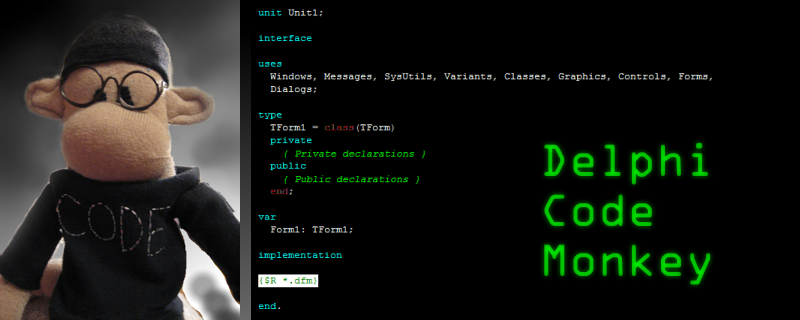Sunday, April 8, 2012
Delphi and OS/2
The year that Delphi 1.0 was released, my main desktop computer at home, and my computer at work, were both running IBM OS/2 Warp, an operating system that is now 25 years old.
I was employed in 1995 to write software for a large insurance company that had invested heavily in IBM OS/2 Warp, using Visual Age C++, a now dead compiler, IDE and tool set. We wrote scripts and tools in a language called Rexx.
Rexx was a language that was intended to become what Python, Perl, and Ruby later became; Very expressive, dynamic high level languages, but Rexx was not concerned with doing so in any kind of object-oriented way.
OS/2 had a lot of interesting aspects. The desktop environment had a system-level object model much like the Microsoft COM (OLE Automation) model, and it was called the System Object Model (SOM). The desktop was entirely composed of persistent objects which made them much more interesting than the desktop-icon-shortcuts on your windows desktop.
Microsoft is often accused of merely buying technology rather than building it from scratch, since DOS, their first big product other than the ROM-basic that came in early 8-bit computers, was actually acquired from a company called Seattle Computer Products. OS/2 on the other hand, was mostly a home-grown project, jointly developed in its earliest days, by both Microsoft and IBM. An early disagreement about the graphical user interface (presentation manager, written by IBM, versus the Windows codebase and APIs, written of course by Microsoft) lead to a "divorce" between Microsoft and IBM, and IBM took over OS/2 development, and marketing, and subsequently (and rather famously) killed it completely.
Around the same time, IBM did a lot of other creative things, or rather, bought them from other people, and renamed them, and then failed to market them, and killed them completely. One of those clever things was Visual Age SMALLTALK, which is still alive as "VA Smalltalk" sold by Instantiations, Inc. Some of the original IBM smalltalk people (who came to IBM along with visual age itself) are still working on the product, which is an obscure but beautiful little thing. I played around with Smalltalk, but instead of using their lean fast "Rapid application development" I was building using the IBM VA C++ class libraries, which were (like many IBM products) good in theory, and rubbish in real world use. They had adapted a visual-programming system that actually involved "wiring up integrated-circuit-like components", in some really interesting precursor to "dependency injection" and modern OOP. The problem was, that the system was useless in practice. You couldn't use it to build anything more complicated than a HelloWorld demo without it turning into crap. The company I was working for folded up shop. The insurance company client kept its IBM OS/400 based solutions around for a few more years, until they were eventually scrapped, and they moved to a Windows based desktop like everybody else. At one point, the PC world was IBMs to lose, and now that they're insignificant players in the software market, and have exited the PC hardware market completely, I'm almost sad for them. Almost. Because they were so brilliant in some ways, and so inept in other ways. OS/2 was brilliant except when it made me want to tear my hair out, scream, rant, swear, and fuss. I was an OS/2 fan, except when I was an OS/2 hater. It was a pre-emptively multitasking protected mode operating system, and I ran a bulletin board system on it for years. It was a thing of beauty, in its time. A year ago I decided to get a VirtualBox VM working with OS/2 on it. Fun stuff. But I was reminded how very long ago it was. 16 color VGA at 640x480 was the default desktop screen resolution. No PPP or TCP/IP+DHCP out of the box in OS/2 Warp until 4.0. Not much support for any hardware not manufactured by IBM, any date after 1997. Sad really.
Once I learned to use Linux/Unix, and the BSDs, even OS/2's better-than-windows environment doesn't seem that useful or interesting to me. The architecture of a Linux system is far nicer to use, and so flexible and easily tailored, even without looking at any source code. And even the worst GCC and gnu stdlibc releases in all of history, were better and easier to use than the crap that came out of IBM.
So I'm nostalgic, but not really. It was good, but bits of it were rubbish. I enjoyed Rexx programming quite a bit, too, but Python is just so nice that I can't imagine writing scripts in anything like that ever again.
Delphi is still the one and only Visual RAD tool that I have ever found that was any good at all, and worth using. IBM Visual Age C++ and Visual Age Smalltalk are both dead and consigned to the scrap-heap of history, but they had this fascinating "building from parts" and "wiring up components" ideas that nothing, not even Delphi, has been able to equal for sheer coolness. Sad that coolness and proof-of-concepts were all it was really good for.
Subscribe to:
Post Comments (Atom)

No comments:
Post a Comment